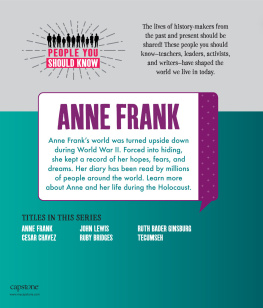Copyright 1984 Houghton Mifflin Harcourt Publishing Company
All rights reserved.
www.hmhco.com
cliffsnotes.com
For information about permission to reproduce selections from this book, write to or to Permissions, Houghton Mifflin Harcourt Publishing Company, 3 Park Avenue, 19th Floor, New York, New York 10016.
The publisher and the author make no representations or warranties with respect to the accuracy or completeness of the contents of this work and specifically disclaim all warranties, including without limitation warranties of fitness for a particular purpose. No warranty may be created or extended by sales or promotional materials. The advice and strategies contained herein may not be suitable for every situation. This work is sold with the understanding that the publisher is not engaged in rendering legal, accounting, or other professional services. If professional assistance is required, the services of a competent professional person should be sought. Neither the publisher nor the author shall be liable for damages arising herefrom. The fact that an organization or website is referred to in this work as a citation and/or a potential source of further information does not mean that the author or the publisher endorses the information the organization or website may provide or recommendations it may make. Further, readers should be aware that Internet websites listed in this work may have changed or disappeared between when this work was written and when it is read.
Trademarks: CliffsNotes, the CliffsNotes logo, Cliffs, cliffsnotes.com, and all related trademarks, logos, and trade dress are trademarks or registered trademarks of Houghton Mifflin Harcourt Publishing Company. All other trademarks are the property of their respective owners. Houghton Mifflin Harcourt is not associated with any product or vendor mentioned in this book.
eISBN 978-0-544-18121-2
v1.0816
About The Diary of Anne Frank
... ideals, dreams, and cherished hopes rise within us only to meet the horrible truth and be shattered... yet in spite of everything I still believe that people are really good at heart.
Anne Frank
July 15, 1944
Anne Franks Diary is not a novel or a tale of the imagination. It is the diary kept by a young Jewish girl for the two years she was forced to remain in hiding by the Nazi persecution of the Jews of Europe. Between June 1942 and August 1944, from Annes thirteenth birthday until shortly after her fifteenth birthday, Anne Frank recorded her feelings, her emotions, and her thoughts, as well as the events that happened to her, in the diary which her father had given her as a birthday present. Together with her parents and her sister, Margot, the Van Daan family (consisting of a husband, a wife, and a son, Peter, two years older than Anne) and, later on, an elderly dentist named Mr. Dussel, Anne lived in a set of rooms at the top of an old warehouse in Amsterdam, Holland, concealed behind a hidden door and a bookcase. During the day, when people worked in the office and in the warehouse below, Anne and the others had to keep very quiet, but at night they could move around more freely, though of course they could not turn on any lights nor show in any way that the house was inhabited.
The Diary is many things at one and the same time. It is an amusing, enlightening, and often moving account of the process of adolescence, as Anne describes her thoughts and feelings about herself and the people around her, the world at large, and life in general. It is an accurate record of the way a young girl grows up and matures, in the very special circumstances in which Anne found herself throughout the two years during which she was in hiding. And it is also a vividly terrifying description of what it was like to be a Jewand in hidingat a time when the Nazis sought to kill all the Jews of Europe.
Above all, Anne was an ordinary girl, growing up, and eventually dying, but she was an ordinary girl growing up in extraordinary times. She loved life and laughter, was interested in history and movie stars, Greek mythology, and cats, writing, and boys. In the few entries which she wrote before the family went into hiding, we discover something of the world of a child growing up in Holland in 1942. Anne went to school, had girl friends and boyfriends, went to parties and to ice-cream parlors, rode her bike, and chattered (an understatement) in class. In fact, Anne chattered so much that, as a punishment for her talkativeness, she had to write several essays on the subject of A Chatterbox. Much of this chatty quality of hers, however, spills over onto the pages of her diary, where we often feel as if she is a good friend who is confiding in us. Although the world of that period is divided from us by more than mere years, Annes voice is very contemporary, and many of her thoughts and problems are very much like those of any youngster growing up both then and now.
Anne Frank did not survive the concentration camps to which she was sent after her little group was discovered. Of all the eight people who hid in the Secret Annexe in Amsterdam, only Annes father survived. The pages of Annes diary, which the Nazis left scattered on the floor when they arrested the group in hiding, were kept by the two young women who had worked in the office and had faithfully supplied the little group with food and other provisions. When Mr. Frank returned after the war, they gave him the pages of Annes diary, and he eventually published them. And so, although Anne died, as the Nazis had intended, her spirit lives on, through her Diary, stronger and clearer by far than any brute force or blind hatred.
Historical Background
The events recounted in Anne Franks diary take place during World War II, in which almost all the countries of Europe, as well as the U.S.A. and Japan, were involved to a greater or lesser extent between 1939 and 1945. The reasons for the war are many and varied, and even the historians are not fully in agreement as to the precise causes, some blaming the harsh conditions and economic penalties imposed on Germany after its defeat in World War I, others claiming that it was the weakness of the European countries after Hitlers rise to power in Germany that was the indirect cause. All are agreed, however, that had it not been for Hitler and his policies, the war would not have taken place.
In addition to the various military engagements, however, the Nazis were engaged in a systematic attempt to kill off certain sections of the populationprimarily Jews and Gypsiesboth within Germany and in the countries which they occupied, claiming that they were racially inferior. The murder of mentally retarded and psychologically disturbed people, as well as homosexuals, was also official Nazi policy. In some cases, these people were made to work as slaves before they were killed, so that the Nazis could benefit as much as possible from their labor. To implement this scheme, the Nazis established huge concentration camps, or death camps, throughout Europe. Jews and other people were sent there in cattle trains, and upon arrival, their heads were shaved and their arms were tattooed with numbers; in addition, they were stripped of their clothes and whatever possessions they still had. They were made to work and were subjected to the strictest discipline and the most inhumane conditions before they were gassed in special chambers and their bodies burned. In those parts of Europe which were occupied by the Nazis, but where these methods of killing large numbers of people had not yet been established, the Nazis assembled large numbers of Jews and machine-gunned them all as they stood on the edge of huge pits which they had dug themselves, or beside natural, deep ravines, as was the case at Babi Yar, in Russia. In other places, the Nazis herded all the local Jews into the synagogue and then set it on fire.
Next page








